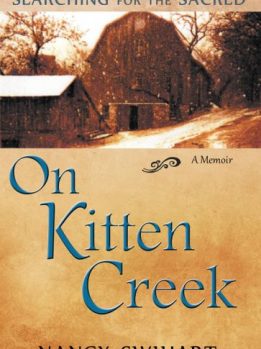“Are you hungry for a life that is more than simple existence, for something to give you hope, for surprises bathed in an eternal aura? Do you long for fellow travelers, for genuine community, a place where you can tell your story and listen to others? With whom you can share life and experience mission?”
So begins the book ON KITTEN CREEK: Searching for the Sacred by Nancy Swihart
God seems to make sacred the places where true Christian fellowship and community happen.
Inspired by Francis and Edith Schaeffer’s L’Abri center in Switzerland, Nancy Swihart and her husband dreamed of starting something similar in America, where people could come to learn about and experience—away from their usual distractions—”the God who is there.”
When the Swiharts left their thriving ministries, that were full of “promise” in Southern California and moved to a rustic, old 160-acre farm in the Flint Hills of Kansas, a missional center developed that came to be known as “Wellspring.” This loosely formed, and constantly evolving and renewing fellowship of folks experienced true, transformational community. Through the past thirty years, thousands of people of all ages have benefited from what Wellspring has offered in sacramental, creative, loving, and edifying ways.
 Nancy’s memoir released this week.to the following praise:
Nancy’s memoir released this week.to the following praise:
“Nancy Swihart’s On Kitten Creek is an uplifting and thoughtful read. It will minister to your spirit and move you to give thanks for life’s simple gifts and cause you to reflect deeply about your life, as it has prompted me.” –Ken Canfield PhD., Founder National Center for Fathering; President, National Association for Grandparenting
“Let Nancy give you glimpses of His handiwork among us. Be inspired to look for sacred connections and creative opportunities waiting to surprise you within what may seem mundane in your own life.” –Kay Bascom, Author, Teacher, Missionary, and Conference Speaker
“A look over-the-shoulder and through-the-heart of someone with much to teach every one of us.” –Steven Garber, Principal of the Washington Institute for Faith, Vocation & Culture; author of Visions of Vocation: Common Grace for the Common Good
 I first met Nancy at the Colorado Christian Writers Conference. Drawn by her warm smile, I became convinced that her story fit every part of Cladach’s stated purpose to:
I first met Nancy at the Colorado Christian Writers Conference. Drawn by her warm smile, I became convinced that her story fit every part of Cladach’s stated purpose to:
• exalt Christ as Savior and Lord, and know God as Creator, Father, and Redeemer-King.
• witness to His presence and work in creation, and in our world today.
• encourage believers in a mind-set and heart experience of joyful faith and obedience.
• provide practical guidance for developing a life of health and wholeness.
• through the power of story, depict grace to a postmodern world.
Nancy practices listening prayer, gives of herself in hospitality, has searched for and found the sacred in her daily life, and has embraced mystery in the mundane—while caring for farm animals, taking prayer walks on the farm trails, hosting ministry events in the barn, or teaching at a Christian college and giving hospitality to students. Active in local churches, schools, and wider ministries, the Swiharts and their friends together have dreamed, laughed, cried, celebrated, served and shared the life of Christ creatively in ways we all long for.
Let Nancy inspire you to embrace the story that God is writing in your own life!
Amazon currently has the price discounted from $13.49 to $8.83. It’s also available in Kindle and Nook.
Here’s a picture of the Wellspring barn (that is on the book cover) in more recent years undergoing a remodel:

Nancy with two farm animals, including “Donk” who is in the book.

Nancy with friends at her book-signing in the barn yesterday.

A beautiful tower of books:

On Kitten Creek







